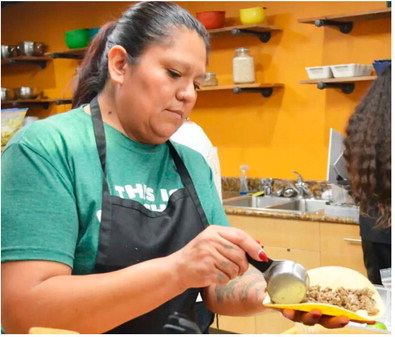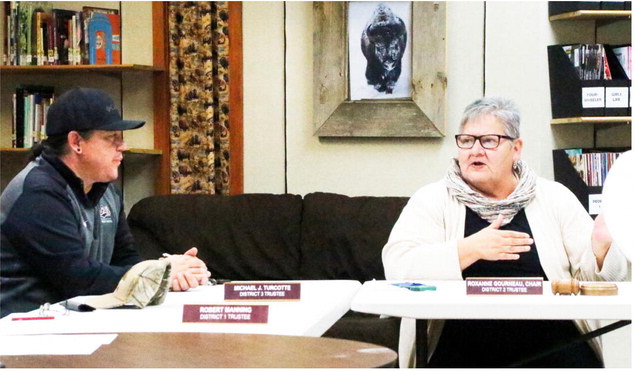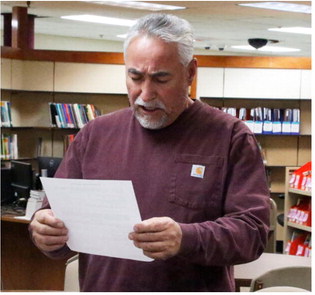Indigenous Cooking Class Promotes Nutrition, Culture


MISSOULA — On a Tuesday evening in late October, the smell of cooking onions and meat combined with the sound of lively chatter to create a friendly warmth in Missoula Food Bank’s learning kitchen as about a dozen people prepared bison salsa verde enchiladas.
The cooking class, held by All Nations Health Center on Oct. 22, was the second of a three-part series focused on meal prep and Indigenous nutrition.
After explaining the recipe, Érica Rubino, the registered dietitian leading the class, wandered among the hotplate stations giving directions and advice.
“If you’ve made ground meat before, follow your heart,” she said to the class. “Or you can follow the instructions.”
As they chopped onions, sautéed ground bison and assembled the enchiladas, participants visited with each other, passed around utensils and shared ingredients like olive oil and garlic.
“When you’re cooking, there’s not a right or wrong way,” Rubino said.
The enchiladas were a “take-and-bake” recipe because of the class’ limited timeframe, and many class members said they were looking forward to eating the meal at home.
“It’s really exciting to have access to bison,” said participant May-Lyric Smith. “It’s nice to cook traditional foods in a contemporary way.”
Sidney Fellows said she was “stoked about the food” but also appreciated the class’ focus on Indigenous food nutrition and practical skills.
“I have cooked with bison but not a lot,” she said. “It’s nice to have classes to learn how to cook in ways maybe I wouldn’t think of.”
About half of the participants also attended the first class in the series in September, during which they made the salsa verde used in the enchiladas.
Dawn Yellowbird said the last class was really good and she likes discovering new things to cook and meeting new people.
“I’m not from here, and I don’t have friends in town,” she said, “I like to be around other Indigenous people and I like cooking.”
The social aspect of the class was a major draw for Valerie Costilla. It was also an opportunity to learn a new recipe and cook with her daughter, she said.
“I encouraged her to go to this one to meet other people and enjoy the atmosphere, which to me is family-based,” Costilla said.
Class organizer Valene TalksDifferent, an All Nations health promotion specialist, said she liked seeing people from the same households working together and the participants sharing knowledge with each other.
The program provides the community with access to food, knowledge and kitchen supplies raffled off at the end of each class, TalksDifferent said. It also aims to reduce chronic diseases by providing access to nutritious and traditional foods and showing how to cook them, she said.
All Nations uses bison in various programs, including most of its cooking classes, TalksDifferent said. This year, the organization received bison from Bitterroot Bison ranch, and will use all parts of the animal, she said.
The series emphasizes food sovereignty — the ability of communities to control what they eat and how — by using traditional ingredients like bison and tomatillos grown in the All Nations garden, TalksDifferent said.
The organization has held a variety of events centered around nutrition, including in-person and virtual cooking demonstrations and a farmers market scavenger hunt.
On Nov. 19, the third class in the Indigenous sovereignty and meal prep series will start with tips on how to effectively grocery shop and get the most out of those groceries, TalksDifferent said.
While preparing for the cooking classes is a lot of work, it’s meaningful, she said.
“I love connecting with community members and reconnecting them to traditional foods and their identity,” TalksDifferent said. “I’m reconnecting with my identity.”
Most of the cooking classes and demonstrations tie culture into healthy cooking and include diabetes prevention or management strategies, said Rubino, the dietitian who led the October class. That’s important because diabetes is prevalent in the Indigenous community, she said.
In 2023, about 13% of American Indian/Alaska Native adults had been diagnosed with diabetes, making them 1.5 times more likely to have the disease than white adults, according to the U.S. Department of Health and Human Services.
Rubino said she lets her classes know she is not Native and works with All Nations staff to make sure information is culturally relevant and appropriate.
Bison is the main traditional ingredient in most recipes Rubino teaches for All Nations, she said. From a diabetes prevention or management standpoint, bison is a leaner alternative to ground beef, Rubino said.
The nutrition program is part of All Nations’ chronic disease and diabetes prevention grant requirements but also offers classes that are useful and practical to the community, Rubio said.
“For any health professional, you can tell someone the concerns and risks but that doesn’t mean it will turn into a behavior change,” she said. “Having someone participate and do work is how people learn and how to engage people. … If you don’t know how to cook, you can have someone show you and support you. It makes such a difference to be hands-on and participate, rather than just hearing about it.”
For the upcoming grocery store tour event, Rubino will focus on explaining nutrition facts included on items and giving tips for eating with diabetes or other diet modifications.
If she had unlimited time during the event, Rubino said she would discuss the layout of the grocery store and how food companies influence where items are located. For example, many less nutritious items are at eye level on shelves or close to the cashiers, she said.
Rubino said she would explain the benefits of shopping the perimeter of the store first where less-processed foods like produce and meat are located. She would also ask participants what common ingredients they purchase and give tips on how to choose items that are more nutritious and better priced.
“The store for some people is very frustrating and overwhelming. They don’t know what they’re supposed to be looking for,” she said. “There are a lot of tips and tricks to keep prices low, especially with how high prices are right now, that comes with having knowledge of the layout.”
Rubino said health can look different for everyone. Eating and cooking healthily doesn’t mean making everything from scratch or only using organic ingredients, she said.
“It’s OK if people didn’t grow up cooking and want to learn,” Rubino said. “The more you look at recipes and try it out, that’s how you learn. Whenever you can get support, that makes a big difference, but keep trying because healthy eating can look like a lot of different things. There’s not just one way.”
For Costilla, part of the mother-daughter duo at the Oct. 22 class, the event provided a supportive environment for cooking, something that’s usually stressful.
“This is nice,” she said, wrapping up her prepared enchiladas. “We’ll see how it tastes tonight.”


